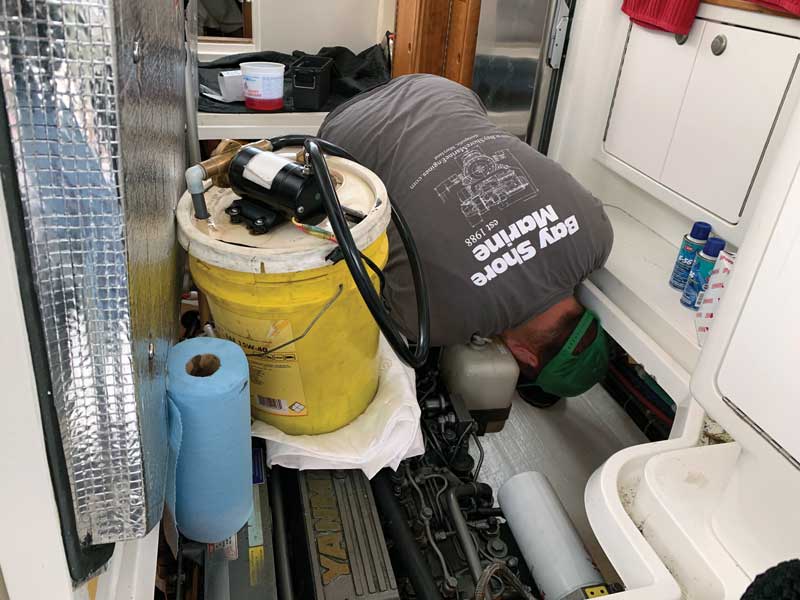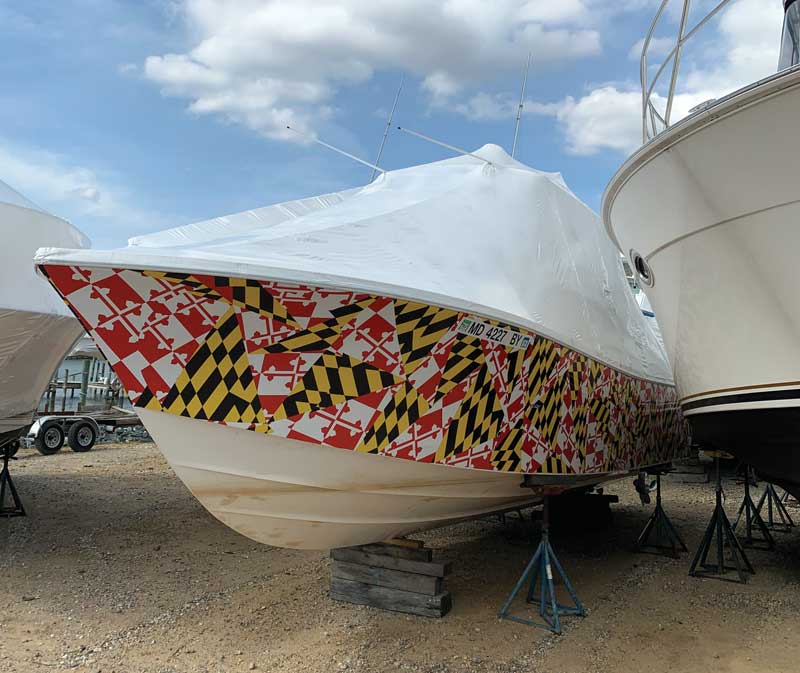Now that spring (and spring commissioning season) has come to the Chesapeake Bay, boaters will be running to their marina hoping to get their boat in the water as soon as possible. But getting any vessel ready to splash after months of sitting idle is no small task. If you want to be the first out of the gate and into the water, keep these tips in mind. We also suggest consulting BoatUS articles, the pros at your local boating store, and your marina regarding any work that needs to be done, shrinkwrap recycling, and launch schedules.

BoatUS is a great resource for the DIY’ers and we especially love their handy spring commissioning checklist:
Spring Commissioning: Before You Launch
- Inspect and replace hose clamps as necessary. Double clamp fuel lines and exhaust hoses with marine-rated stainless steel hose clamps. While not technically required, it’s a wise move to double clamp whenever possible on all hoses—especially those below the waterline.
- Inspect all hoses for stiffness, rot, leaks, and cracking, and replace any that are faulty. Make sure they fit snugly.
- Inspect prop(s) for dings, pitting, and distortion. Make sure cotter pins are secure.
- Grip the prop (on inboard drive systems) and try moving the shaft up and down and side to side. If it’s loose and can be wiggled, the cutless bearing may need to be replaced.
- Check the rudderstock to ensure it hasn’t been bent. Operate the wheel or tiller to ensure the steering works correctly.
- Inspect the hull for blisters, distortions, and stress cracks.
- Make sure your engine intake sea strainer (if equipped) is not cracked or bent from ice and is free of corrosion, is clean, and properly secured.
- With inboards, check the engine shaft and rudder stuffing boxes for correct adjustment. A stuffing box should leak no more than two drops each minute when the prop shaft is turning.
- Inspect, lubricate, and exercise seacocks.
- Use a garden hose to check for deck leaks at ports and hatches. Renew caulk or gaskets as necessary.
- Inspect and test the bilge pump and float switch to make sure they’re both working properly.
- Check stove and remote LPG tanks for loose fittings and leaking hoses.
- Inspect dock and anchor lines for chafe and wear.
- If equipped, ensure that the stern drain plug is installed.
- After the boat is launched, be sure to check all thru-hulls for leaks.
Engines and Fuel Systems
- Inspect fuel lines, including fill and vent hoses, for softness, brittleness, or cracking. Check all joints for leaks, and make sure all lines are well supported with noncombustible clips or straps with smooth edges.
- Inspect fuel tanks, fuel pumps, and filters for leaks. Ensure portable tanks and lines are completely drained of stale fuel before filling with fresh fuel. Clean or replace fuel filters and/or fuel-water separators if not done before winterization.
- Every few years, remove and inspect exhaust manifolds for corrosion (for inboard-powered and inboard/outboard boats).
- Charge battery.
- Clean and tighten electrical connections, especially both ends of battery cables. Use a wire brush to clean battery terminals, and top up cells with distilled water (if applicable).
- Inspect the bilge blower hose for leaks and run the blower to confirm correct operation.

Engine Outdrives and Outboards
- Inspect rubber outdrive bellows for cracked, dried, and/or deteriorated spots (look especially in the folds) and replace if suspect.
- Check power steering and power trim oil levels.
- Replace anodes/zincs that are more than half wasted.
- Inspect the outer jacket of control cables. Cracks or swelling indicate corrosion and mean that the cable must be replaced.
- Inspect lower unit oil level and top up as necessary.
Safety Equipment
- Check expiration dates on flares.
- Inspect fire extinguishers. Replace if more than 12 years old or if age is unknown. More than 40 million Kidde extinguishers with plastic handles were recalled on November 2, 2017.
- Ensure you have properly sized and wearable life jackets in good condition for each passenger, including kids. Check inflatable life jacket cylinders and dissolvable “pill” bobbins in auto-inflating models.
- Test smoke, carbon monoxide, fume, and bilge alarms.
- Check running lights for operation and spare bulb inventory.
- Update paper charts and chartplotter software.
- Replenish first-aid kit items that may have been used last season or are expired.
- Check the operation of VHF radio(s) and that the MMSI number is correctly programmed in. (BoatUS members can obtain a free MMSI number at BoatUS.com/MMSI.)
- Get a free vessel safety check from the U.S. Coast Guard Auxiliary or U.S. Power Squadrons.
Boat Trailers
- Inspect tire treads and sidewalls for cracks or lack of tread and replace as necessary. Check air pressure; don’t forget the spare.
- Inspect wheel bearings and repack as necessary.
- Test all lights and replace any broken bulbs or lenses.
- Inspect winch to make sure it’s working properly. Inspect hitch chains.
- Inspect trailer frame for rust. Sand and paint to prevent further deterioration.
- Inspect brakes and brake fluid reservoir.
Documents
- Make sure your boat registration is up to date. Don’t forget your trailer tags.
- Review your boat insurance policy and update coverage if needed.
All of these tips are courtesy of BoatUS. For more, visit boatus.com.
Shakedown Cruise
Once you feel you’ve checked everything off of your spring commissioning checklist, it’s time for a shakedown cruise. Take along another boater to drive so you can look around the whole boat while underway. Don’t plan a big day of boating with a bunch of friends. That’s a recipe for disappointment, because no matter how carefully you may have winterized and commissioned the boat, there’s always a chance that you’ll discover maintenance or repair issues that will need to be addressed.
Test everything you can, from your throttle and kill-switch to transmission controls and navigational electronics. Spend at least an hour underway. It’s better to discover problems now than to risk being surprised farther from port.
Also, try to enjoy yourself. You’ve been cooped up all winter so even if you discover problems underway, at least you got out on the water to experience the wind in your hair and the sun on your face.

Shrinkwrap or a Reusable Cover?
Spring brings the excitement of unwrapping your boat from its long winter’s nap. Some people use shrinkwrap, while others use tarps or reusable covers. Cost, effectiveness, environmental impact, and investment of your time and are probably the three main considerations when deciding whether to protect your boat with a reusable cover or an annual shrinkwrap job. Here are a few considerations to keep in mind for the future:
Shrinkwrap Advantages:
- highly effective protection
- time efficient for owner because usually outsourced to a professional
- won’t blow off
- less initial cash outlay
- waterproof and usually no “puddling” rainwater or snow
Shrinkwrap Disadvantages:
- cumbersome to recycle properly; zippers and snaps must be removed
- sometimes difficult to find a reputable recycling vendor
- takes up space in a landfill if not properly recycled
- costs incurred annually for product and installation
- must address humidity control issues inside of boat
- DIY application can be dangerous, time consuming, or ineffective
Reusable Cover Advantages:
- initial investment lasts for years
- environmentally friendly
- breathable
- can be put on without hiring a pro
Reusable Cover Disadvantages:
- initial investment cost
- cleaning and repairs
- potential for “puddles” of rainwater or snow
- may tear
- may blow off if not installed properly or has poor fit